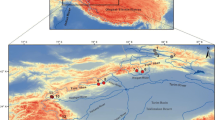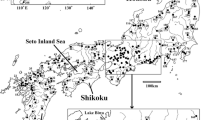Abstract
The genus Rutilus is a widely distributed lineage of cyprinids and ranges from West Europe to East Siberia. Although matrilineal phylogeny and phylogeography of western species were already studied, roaches from remaining part of the range were not examined. Phylogenetic analysis based on cytochrome b sequences detected the following three major phylogenetic clades: (i) R. frisii, (ii) R. rutilus s. str., and (iii) group of six Ponto–Caspian taxa: R. caspicus, R. heckelii, R. rutilus aralensis, R. rutilus lacustris, R. schelkovnikovi, and R. stoumboudae. Our results suggest that these “species” within Ponto–Caspian clade could be a single species (R. lacustris by priority of description). The Ponto–Caspian clade is most widely distributed among others and covers the freshwaters from the Aegean Sea basin to Laptev Sea tributaries. Both R. rutilus s. str. and Ponto–Caspian clades sympatrically occur in Black Sea and Caspian Sea basins, Azov Sea itself, and even in drainage of White Sea. The vastest zone of contact (approximately 1700 km) was detected in the Volga basin. The spatial pattern of haplotype diversity and the shape of haplotype network argued for multiple refugia in Ponto–Caspian region as well as a rapid post-glacial colonization of Volga River and Siberia.



Similar content being viewed by others
References
Aljanabi, S. M. & I. Martinez, 1997. Universal and rapid salt-extraction of high quality genomic DNA for PCR-based techniques. Nucleic Acids Research 25: 4692–4693.
Bandelt, H., P. Forster & A. Röhl, 1999. Median-joining networks for inferring intraspecific phylogenies. Molecular Biology and Evolution 16: 37–48.
Berg, L. S., 1949. Fishes of fresh waters of the USSR and adjacent countries. Pt. 2.
Bernatchez, L., 2001. The evolutionary history of brown trout (Salmo trutta L.) inferred from phylogeographic, nested clade, and mismatch analyses of mitochondrial DNA variation. Evolution 55: 351–379.
Bianco, P. G. & V. Ketmaier, 2014. A revision of the Rutilus complex from Mediterranean Europe with description of a new genus, Sarmarutilus, and a new species, Rutilus stoumboudae (Teleostei: Cyprinidae). Zootaxa 3841: 379–402.
Bogutskaya, N. G. & A. M. Naseka, 2004. Catalogue of Agnathans and Fishes of Fresh and Brackish Waters of Russia with Comments on Nomenclature and Taxonomy. The Russian Academy of Sciences, Moscow. (in Russian).
Culling, M. A., K. Janko, A. Boron, V. P. Vasil’ev, I. M. Côté & G. M. Hewitt, 2006. European colonization by the spined loach (Cobitis taenia) from Ponto–Caspian refugia based on mitochondrial DNA variation. Molecular Ecology 15: 173–190.
Dadikyan, M. G., 1986. Fishes of Armenia. AN Arm. SSR, Erevan. (in Russian).
Dukravets, G. M. & E. L. Markova, 1987. Rutilus rutilus aralensis Berg. In Fishes of Kazakhstan. Nauka, Alma Ata, Vol. 2: 32–50 (in Russian).
Dürand, J. D., H. Persat & Y. Bouvet, 1999. Phylogeography and postglacial dispersion of the chub (Leuciscus cephalus) in Europe. Molecular Ecology 8: 989–997.
Dürand, J. D., C. S. Tsigenopoulos, E. Ünlü & P. Berrebi, 2002. Phylogeny and biogeography of the family Cyprinidae in the Middle East inferred from cytochrome b DNA—evolutionary significance of this region. Molecular Phylogenetics and Evolution 22: 91–100.
Hänfling, B., C. Dümpelmann, N. G. Bogutskaya, R. Brandl & M. Brändle, 2009. Shallow phylogeographic structuring of Vimba vimba across Europe suggests two distinct refugia during the last glaciation. Journal of Fish Biology 75: 2269–2286.
Helaers, R. & M. C. Milinkovitch, 2010. MetaPIGA v2.0: maximum likelihood large phylogeny estimation using the metapopulation genetic algorithm and other stochastic heuristics. BMC Bioinformatics 11: 379.
Hewitt, G. M., 2004. Genetic consequences of climatic oscillations in the Quaternary. Philosophical Transactions of the Royal Society of London B: Biological Sciences 359: 183–195.
Kasyanov, A. N., 1983. To the taxonomic status of roach Rutilus rutilus (L.) in the Volga basin. Biology of Inland Waters 60: 51–54. (in Russian).
Ketmaier, V., P. G. Bianco & J. D. Dürand, 2008. Molecular systematics, phylogeny and biogeography of roaches (Rutilus, Teleostei, Cyprinidae). Molecular Phylogenetics and Evolution 49: 362–367.
Knowles, L. L., 2001. Did the Pleistocene glaciations promote divergence? Tests of explicit refugial models in montane grasshopprers. Molecular Ecology 10: 691–701.
Kozhara, A. V., 1997. Regular phenotypic changes accompanying osmotic adaptations in some cyprinids: micro vs macroevolution. Zhurnal obshchei biologii 58: 17–26.
Kozhara, A. V. & A. N. Mironovsky, 1995. Selection for tolerance to the increased mineralization—a possible factor of intraspecific divergence in the bream (Abramis brama (L), Cypriniformes, Cyprinidae) from the Caspian Sea drainage. Zhurnal Obshchei Biologii 56: 239–247.
Kotlik, P., N. G. Bogutskaya & F. G. Ekmekci, 2004. Circum Black Sea phylogeography of Barbus freshwater fishes: divergence in the Pontic glacial refugium. Molecular Ecology 13: 87–95.
Kotlik, P., S. Markova, L. Choleva, N. G. Bogutskaya, F. G. Ekmekci & P. P. Ivanova, 2008. Divergence with gene flow between Ponto–Caspian refugia in an anadromous cyprinid Rutilus frisii revealed by multiple gene phylogeography. Molecular Ecology 17: 1076–1088.
Kottelat, M. & J. Freyhof, 2007. HANDBOOK of European Freshwater Fishes. Publications Kottelat, Cornol.
Larmuseau, M. H. D., J. Freyhof, F. A. M. Volckaert & J. K. J. Van Houdt, 2009. Matrilinear phylogeography and demographical patterns of Rutilus rutilus: implications for taxonomy and conservation. Journal of Fish Biology 75: 332–353.
Leigh, J. W. & D. Bryant, 2015. Popart: full-feature software for haplotype network construction. Methods in Ecology and Evolution 6: 1110–1116.
Levin, B. A. & M. A. Levina, 2015. About species status and the phylogenetic position of the roaches of the genus Rutilus in the Rybinsk Reservoir. In Gerassimov, Yu V (ed.), Fishes of the Rybinskoe Reservoir: Population Dynamics and Ecology. Filigran, Yaroslavl: 265–270.
Librado, P. & J. Rozas, 2009. DnaSP v5: a software for comprehensive analysis of DNA polymorphism data. Bioinformatics 25: 1451–1452.
Machordom, A. & I. Doadrio, 2001. Evidence of a Cenozoic Betic-Kabilian connection based on freshwater fish phylogeography (Luciobarbus, Cyprinidae). Molecular Phylogenetics and Evolution 18: 252–263.
Mina, M. V., Y. S. Reshetnikov & Y. Y. Dgebuadze, 2006. Taxonomic novelties and problems for users. Journal of Ichthyology 46: 476–480.
Mironovsky, A. N., Yu G Iziumov, A. N. Kasyanov & O. G. Vaniushina, 1991. On possible meaning of permanent intensive disruptive selection as a factor determining phenetic structure of Rutilus rutilus (L.) in the Volga-Caspian region. Zhurnal Obshchei Biologii 52: 656–672. (in Russian).
Nelson, J. S., T. C. Grande & M. V. H. Wilson, 2016. Fishes of the World, 5th ed. Wiley, Hoboken.
Pallas, P. S., 1814. Zoographia Rosso-Asiatica: sistens omnium animalium in extenso Imperio Rossico et adiacentibus maribus observatorum recensionem, domicilia, mores et descriptiones anatomen atque icones plurimorum. Vol. 1. Petropoli.
Palumbi, S. R., 1996. Nucleic acids II: the polymerase chain reaction. Molecular Systematics 2: 205–247.
Perdices, A. & I. Doadrio, 2001. The molecular systematics and biogeography of the European cobitids based on mitochondrial DNA sequences. Molecular Phylogenetics and Evolution 19: 468–478.
Perea, S., M. Böhme, P. Zupančič, J. Freyhof, R. Šanda, M. Özuluğ, A. Abdoli & I. Doadrio, 2010. Phylogenetic relationships and biogeographical patterns in Circum-Mediterranean subfamily Leuciscinae (Teleostei, Cyprinidae) inferred from both mitochondrial and nuclear data. BMC Evolutionary Biology 10: 1.
Posada, D., 2009. Selection of models of DNA evolution with jMODELTEST. Bioinformatics for DNA Sequence Analysis 537: 93–112.
QGIS Development Team, 2016. QGIS Geographic Information System. Open Source Geospatial Foundation Project: http://qgis.osgeo.org.
Rambaut, A., 2008. FigTree v1.4: tree figure drawing tool [available at http://tree.bio.ed.ac.uk/software/figtree/].
Rambaut, A., M. A. Suchard, D. Xie & A. J. Drummond, 2014. Tracer v1.6 [available at http://beast.bio.ed.ac.uk/Tracer].
Reshetnikov, Yu S, O. A. Popova & L. I. Sokolov, 2003. Atlas of Russian Freshwater Fishes, Vol. 1. Nauka, Moscow.
Ronquist, F., M. Teslenko, P. van der Mark, D. L. Ayres, A. Darling, S. Höhna, B. Larget, L. Liu, M. A. Suchard & J. P. Huelsenbeck, 2012. MrBayes 3.2: efficient Bayesian phylogenetic inference and model choice across a large model space. Systematic Biology 61: 539–542.
Seifertová, M., J. Bryja, M. Vyskočilová, N. Martínková & A. Šimková, 2012. Multiple Pleistocene refugia and post-glacial colonization in the European chub (Squalius cephalus) revealed by combined use of nuclear and mitochondrial markers. Journal of Biogeography 39: 1024–1040.
Stierandová, S., J. Vukić, E. D. Vasil’eva, S. Zogaris, S. Shumka, K. Halačka, L. Vetešník, M. Švátora, M. Nowak, T. Stefanov, J. Koščo & J. Mendel, 2016. A multilocus assessment of nuclear and mitochondrial sequence data elucidates phylogenetic relationships among European spirlins (Alburnoides, Cyprinidae). Molecular Phylogenetics and Evolution 9: 479–491.
Tamura, K., G. Stecher, D. Peterson, A. Filipski & S. Kumar, 2013. MEGA6: molecular evolutionary genetics analysis version 6.0. Molecular Biology and Evolution 30: 2725–2729.
Thompson, J. D., T. J. Gibson, F. Plewniak, F. Jeanmougin & D. G. Higgins, 1997. The CLUSTAL_X windows interface: flexible strategies for multiple sequence alignment aided by quality analysis tools. Nucleic Acids Research 25: 4876–4882.
Timoshkina, N. N., A. E. Barmintseva, A. V. Usatov & N. S. Mugue, 2009. Intraspecific genetic polymorphism of Russian sturgeon Acipenser gueldenstaedtii. Russian Journal of Genetics 45: 1098–1106.
Tsoumani, M., A. Georgiadis, I. A. Giantsis, I. Leonardos & A. P. Apostolidis, 2014. Phylogenetic relationships among Southern Balkan Rutilus species inferred from cytochrome b sequence analysis: Micro-geographic resolution and taxonomic implications. Biochemical Systematics and Ecology 54: 172–178.
Zardoya, R. & I. Doadrio, 1999. Molecular evidence on the evolutionary and biogeographical patterns of European cyprinids. Journal of Molecular Evolution 49: 227–237.
Acknowledgments
We are grateful to S.S. Alekseyev, A.A. Bolotovskiy, E.A. Borovikova, V.A. Chernyshov, Yu.V. Gerassimov, V.Y. Ilyin, A.P. Kalinin, A.V. Kozhara, M.P. Matwejev, A.E. Minin, D.D. Pavlov, O.A. Polumordvinov, A.A. Prokin, V.B. Salnikov, I.V. Shlyapkin, and I.S. Voroshilova for sharing of their samples. We are also thankful to N.G. Bogutskaya for providing the literature, to M. H. D. Larmuseau for providing of his unpublished cytb sequences to check some localities, and to N. S. Mugue for doing of first sequences in his lab. This study was supported by grant of the Russian Science Foundation, No. 15-14-10020 (sampling, molecular study, treatment of the results) and by grant of Ministry of Science and Education of Republic of Kazakhstan, №1380GF4 (sampling in Southern Kazakhstan). The Ministry of Education and Science of the Russian Federation provided additional funding to the Penza State University to conduct scientific activity in 2014–2016 (sampling and molecular study of the samples from the Penza Region).
Author information
Authors and Affiliations
Corresponding author
Additional information
Handling editor: Christian Sturmbauer
Rights and permissions
About this article
Cite this article
Levin, B.A., Simonov, E.P., Ermakov, O.A. et al. Phylogeny and phylogeography of the roaches, genus Rutilus (Cyprinidae), at the Eastern part of its range as inferred from mtDNA analysis. Hydrobiologia 788, 33–46 (2017). https://doi.org/10.1007/s10750-016-2984-3
Received:
Revised:
Accepted:
Published:
Issue Date:
DOI: https://doi.org/10.1007/s10750-016-2984-3




